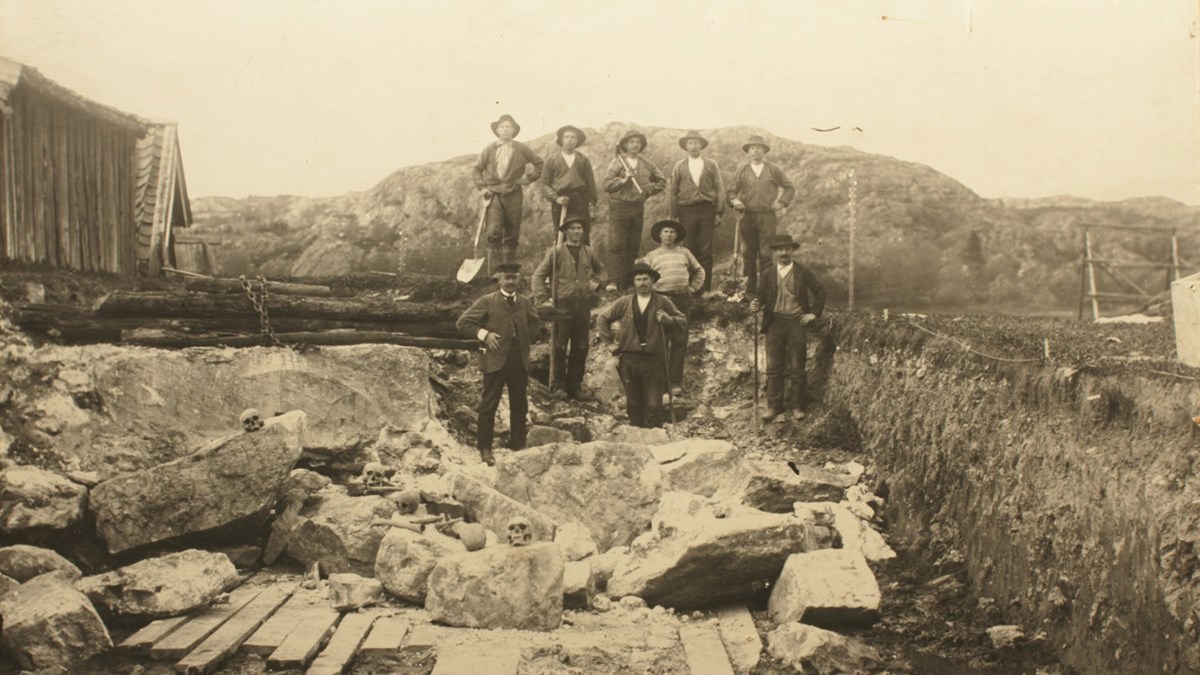Archaeological history

Bang! The archaeological history of Lödöse commenced with a bang at the beginning of the 1900s. And as if that were not enough, parts of skeletons were thrown into the air, frightening the life out of a group of railway workers who were in the process of blasting a rocky outcrop. This marked the start of archaeological excavations in Lödöse.
There are very few written documents from the town of Lödöse that date back to the Middle Ages. Despite the considerable interest in our history during the 18th and 19th centuries, the mediaeval town was overlooked by the historians of the time. Even as late as 1910, Carl af Ugglas stated that knowledge of Lödöse was essentially a matter confined to archaeological circles.
From accident to archaeological discovery
The first archaeological investigation took place largely by accident. When workers were in the process of blasting what they believed to be a rocky outcrop as part of the construction of the railway in 1905, what they in fact hit upon were remnants of the chancel and graveyard of St Olof’s Church.
It was said that remains of skeletons flew into the air and frightened the life out of the railway workers. They called the county sheriff and he in turn summoned an expert to conduct an archaeological investigation. The man in question was headmaster Folke Nordin from Vänersborg. His conclusion was that the site was that of the former hospital in Lödöse, mainly due to the fact that the property designation was Spetalen (derived from the Swedish word for hospital).
Investigations in conjunction with the 300th anniversary celebrations
Eleven years later, a series of archaeological investigations and publications commenced in preparation for the 300th anniversary of the founding of Gothenburg. One of the undertakings was to identify the city’s roots. The task of investigating the first predecessor of Gothenburg, Old Lödöse, was assigned to art historian Carl af Ugglas. Commencing in 1916, the investigations continued for four years. The aim was to acquire as full and comprehensive a picture as possible of the town and with a particular focus on the public buildings.
The investigations centred on the monastery church, St Olof’s, which at the time they believed was St Jörgen’s Hospital. At the fortress, an examination was made of the outer bailey and part of the moat system. The actual fortress mound was the site of a beautiful merchant’s house, which still remains today. Parts of St Peder’s Church, relics of a mill to the north at the foot of the Spetalberget hill, along with parts of the port, were also investigated. The town itself was of secondary importance, although a couple of investigations were carried out.
Due to the volume of the material that was excavated, it took 10 years before Lödöse, Gamla Lödöse – historia och arkeologi was published in 1931. It still remains the most notable written work relating to the history of the town of Lödöse.
The Lödöse shipyard and the mediaeval town
During the 1930s, a few investigations were made of the mediaeval ‘culture layers’ of Lödöse. Municipal water and sewage pipes were laid in Lödöse during the 1940s and 1950s, and this led to a great deal of excavation. Although the archaeological investigations were not comprehensive, they did provide us with a clear idea of the extent of the mediaeval town.
New discoveries as the town expands
In 1958, there was large-scale construction in Lödöse. Antiquarian investigations were almost non-existent. The finding of a grillage system used to strengthen foundations was duly noted, whereupon the remains of mediaeval buildings were removed somewhat unceremoniously by excavator.
Finds result in a museum
Development continued into the 1960s and 1970s. Following an excavation in 1961, an amazing number of finds and building remains emerged, and discussions began about building a museum. Four years later, the museum was finally opened, located in the cellar of an apartment building in Lödöse.
260 archaeological investigations later
The development of Lödöse continued, with numerous archaeological investigations as a result. It was often the case at the end of the 1960s and the beginning of the 1970s that several archaeological investigations were in progress at the same time. The archaeologists enlisted the aid of people on various job creation schemes to assist with the routine work.
Apart from work to rectify water and sewage pipe leaks and a number of research investigations, the last major excavation in Lödöse took place in 1989. The construction in question was the expansion of the parish centre.
Today, with more than 260 investigations and inspections completed, we have acquired a clear impression of what the mediaeval town of Lödöse looked like. Many of the mediaeval objects that were uncovered have attracted considerable attention throughout Sweden and internationally. This applies in particular to coins and minting history, the widespread discovery of pilgrim badges, glass manufacturing, and the production of ceramics.
New knowledge, new questions Many questions still remain, particularly about the oldest parts of Lödöse, and new questions and research findings continue to emerge as the material is processed. What will the picture of mediaeval Lödöse look like in 10 years’ time?






